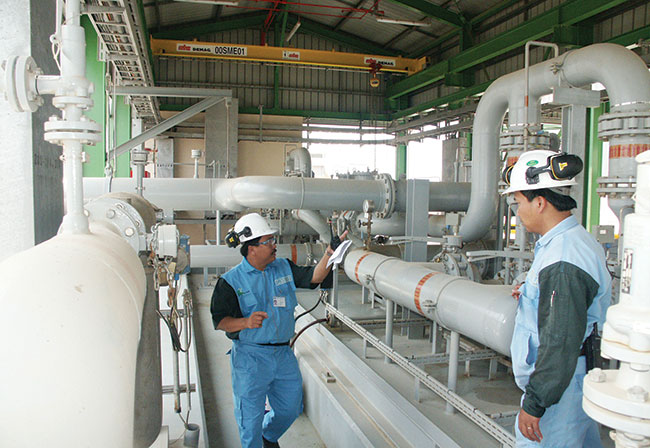Foreign investors power up with raft of new BOT projects

While many MoUs have been signed for power plants, licences have been slow to materialise
Photo: Le Toan
Late last month Thai company One Asian signed a memorandum of understanding (MoU) with the People’s Committee of Quang Tri province to invest approximately $2.4 billion into a 1,200 MW thermal power plant. Construction is expected to start in 2017 and finish in 2019.
Moreover, One Asian will co-operate with the province to research the development of an energy complex in the south east economic zone that would combine power plants with the My Thuy deep water port project. In addition, One Asian wants to develop natural gas-fired power plants to take advantage of the 30 billion cubic metre gas reserve off the central coast of Vietnam.
Also in Quang Tri, another Thai investor, EGATI, is planning to supply $2.26 billion to the Quang Tri thermal power plant project, which will have a capacity of 1,200 MW. Last year, the MoIT and EGATI signed an MoU on the development of this build-operate-transfer (BOT) project. The plant is expected to commence commercial operation in 2021.
Late last month, South Korean group POSCO investigated the site where they will build the Quynh Lap 2 thermal power plant. The plant, with area of 283 hectares and capacity of 2,400 MW, is part of the planned Dong Hoi industrial park in Hoang Mai precinct. The $2 billion plant has not found an investor yet and the People’s Committee of Dong Nai is still searching for funding.
POSCO is likely going to join this BOT project because it’s hoping to expand its portfolio of investment in power generation in Vietnam. Also, asides from its steel projects here, POSCO has co-operated with American company AES on the Mong Duong 2 BOT thermal power project in Quang Ninh province, for which it has made a total investment of about $2 billion. Last year POSCO also signed an MoU with Quang Ninh province to start another BOT thermal plant with capacity of 1,200 MW and an additional investment of $2 billion.
Among the 86 power projects in the Power Master Plan VII, only 18 are set aside for foreign investors, but more and more foreign investors are coming to Vietnam to propose new projects.
At present, several BOT projects are still awaiting a license. Among these is Van Phong 1 thermal power plant, with a capacity of 1,200 MW, which Sumimoto has been persistently pursuing since 2006. According to plan, in the third quarter of this year Sumimoto is going to sign the BOT contract to finally carry out the project.
Another power project seeking licensing is Vung Ang 3 thermal power plant in Ha Tinh province. Recently, however, Samsung C&T signed an MoU with the general department of Energy under the MoIT. With capacity of 1,200 MW, the project is going to start operation in 2022.
Other examples are the Song Hau 2 thermal power project by Malaysia’s Toyo-Ink, the Nghi Son 2 project by Japan’s Marubeni, South Korea’s KEPCO, and Sembcorp’s Quang Ngai thermal power project. India’s Tata Power is not only pursuing the Long Phu 1 thermal power project in Soc Trang province, it is also looking into two other projects with combined capacity of 2,400 MW.
With Vietnam’s energy demands set to outstrip its supply in the years to come, investors and industry leaders are waiting for these BOT projects to be finished and the Power Master Plan VII to be implemented. At the Vietnam Business Forum conference earlier this month, VBF’s Infrastructure Working Group attributed the slowness to overly-complicated procedures.
What the stars mean:
★ Poor ★ ★ Promising ★★★ Good ★★★★ Very good ★★★★★ Exceptional
Latest News
More News
- Vietnam urged to shore up supply-chain resilience amid global uncertainty (December 10, 2025 | 18:47)
- Unpacking new momentum in Vietnam’s M&A market (December 10, 2025 | 09:59)
- Forum honours outstanding M&A deals, strategies, and advisory firms (December 09, 2025 | 18:22)
- Vietnam enters defining phase of M&A growth (December 09, 2025 | 17:00)
- Landscape strong for domestic acquisitions (December 09, 2025 | 15:34)
- FDI in Vietnam jumps on additional capital and share purchases (December 09, 2025 | 13:56)
- THACO and Hyundai Rotem sign strategic railway partnership (December 09, 2025 | 12:14)
- Fundamentals required for M&A wins (December 08, 2025 | 11:08)
- When infrastructure shapes the flow of capital in logistics (December 08, 2025 | 10:39)
- Vietnam positions logistics as strategic growth engine (December 08, 2025 | 08:00)


















 Mobile Version
Mobile Version